Plan your Nanjing Tour? Linggu Temple Scenic Area (灵谷寺)is one of the four major sights in Zhongshan Mountain National Park in Nanjing. The other three are Dr.Sun Yat-sen’s Mausoleum, Sun Yat-sen Mausoleum Music Stage, and Ming Xiaoling Tomb.
How to get to Linggu Tower
Recognized by Google Map as “Linggu Tower”, Linggu Temple Scenic Spot is located about 1.5km to the east of Dr.Sun Yat-sen’s Mausoleum on the southeast slope of Zhongshan Mountain.
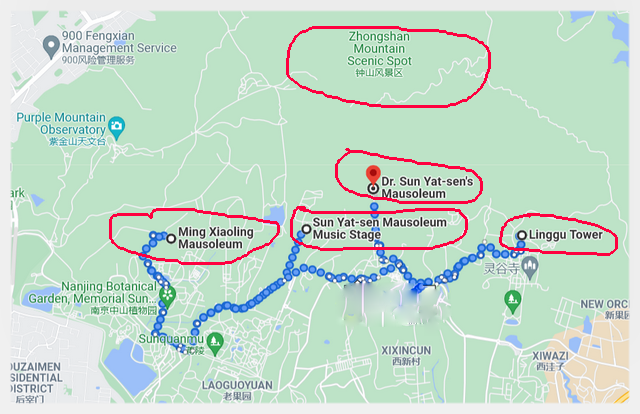
Linggu Temple Scenic Area is named after the namesake temple – Linggu Temple. Now the scenic area is mainly composed of Linggu Temple, Linggu Pagoda (also Linggu Tower), the Beamless Hall, the Entrance Gate, the Paifang and a large screen wall.
1.Take Nanjing Metro Line 2 and get off at “Zhongling Street” station (钟灵街站) and walk along Linggusi Road for about 15 minutes;
2. Take Bus Line 202 and get off at the stop of “Linggu Temple Park” (灵谷寺公园站)
3. Take the sightseeing bus within the park: 1) Take the sightseeing Bus 5 from “Ming Xiaoling (Zixia Lake)”; s or Sightseeing Bus 4 from “Sun Yat-sen’s mausoleum east” and stop at Linggu Tower. This is the tour bus inside Zhongshan Scenic spot, where there are two kinds, the red train and the blue electric car, the ticket price is 5 yuan.
ABC of Linggu Temple Scenic Area
The Linggu Temple was first built in 514 under the reign of the Liang Dynasty (502-557), also known as the Southern Liang Dynasty, the third of the Southern dynasties during China’s Southern and Northern Dynasties period.
It was originally located in the present site of Ming Xiaoling Tomb. Zhu Yuanzhang, the First Ming Dynasty Emperor chose the place as his mausoleum and then had the temple moved to the present place. The Lingu Temple was named by Zhu Yuanzhang himself.
It used to be the largest temple at that time with an area of over 300,000 square metres. Later it was destroyed in a warfare and rebuilt in Qing Dynasty. Only the Beamless Hall was left intact.
From 1928 to 1935 during the Kuomintang Government, the Linggu Temple was gradually built into a cemetery dedicated to the the National Revolutionary Army’s martyrs who gave their lives during the Northern Expedition against the northern warlords and the Anti-Japanese Wall.
After 1949, Lingu Temple was renamed Linggu Temple Park (Linggu Temple Scenic Area). But people still habitually call it Linggu Temple.
The visit to the Linggu Temple Scenic Area is often followed by the pilgrimage trip to Dr.Sun Yat-sen’s Mausoleum Visitors can either walk or take an electric car (also known as sightseeing vehicle) from the parking area at Dr.Sun Yat-sen’s Mausoleum to the Linggu Scenic Area. The transfer ticket costs you RMB 5.
Virtual Tour of Linggu Temple Scenic Area
Follow me to visit the Linggu Temple Scenic Area. Take a sightseeing vehicle for RMB 5 from Dr.Sun Yat-sen’s Mausoleum to the Linggu Temple Park.
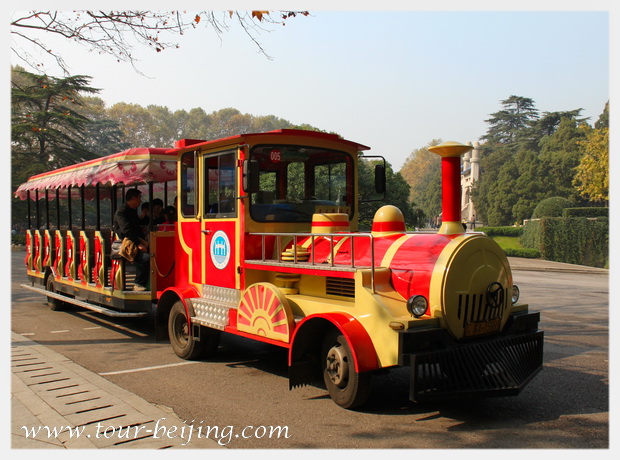
This is the main entrance to the Linggu Scenic Area. The entrance is a three-gate hall, green glazed tiles and red walls on the both sides. By the gate stands a stone sign inscribed with the Chinese characters meaning “The Cemetery dedicated to the the National Revolutionary Army’s martyrs “, indicating that the temple was turned into a cemetery during the reign of Kuomintang Government ( 1928-1949).
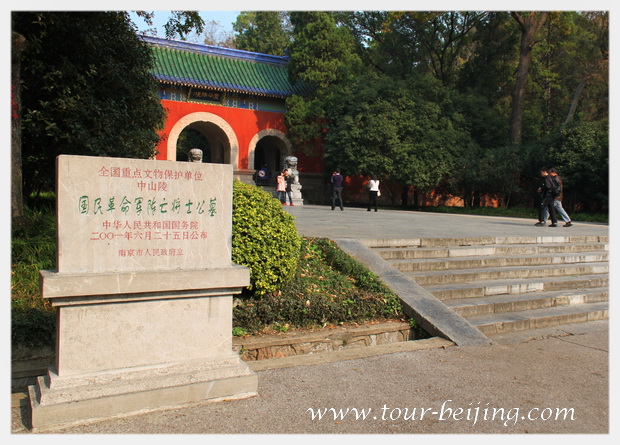
Behind the main entrance, you walk for a while and see a massive and solemn paifang, a traditional Chinese style gating arch, green glazed tiles and inscribed with the the national emblem of the Republic of China.
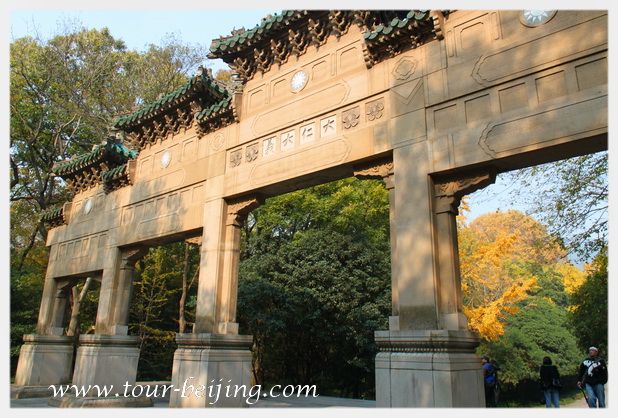
Wuliang Hall, known as Beamless Hall. The Beamless Hall is the only remaining ancient relic in the temple with over 600 years’ history. The hall is 22m high, 46.7m wide. It has three archways. The hall was constructed with bricks and without a piece of wood or a single nail, hence the name of “Wuliang Hall” means “beamless hall”.
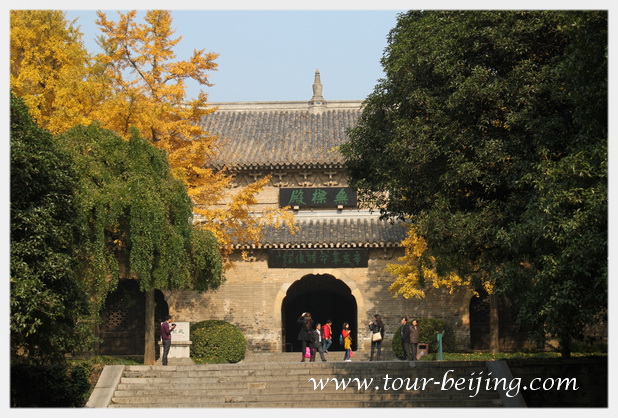
The Hall used to enshrined Amitayus (Buddha of Infinite Life) whose Chinese name has the same pronunciation as that of Wuliang. Later in 1928, the hall was changed into the memorial hall of soldiers who gave their lives in the War of Northern Expedition (1926–1927). Over 30,000 soldiers were enshrined.
A monument to the 19th Route Army Martyrs that primarily led the offensive against the Japanese soldiers invading Shanghai in 1937.
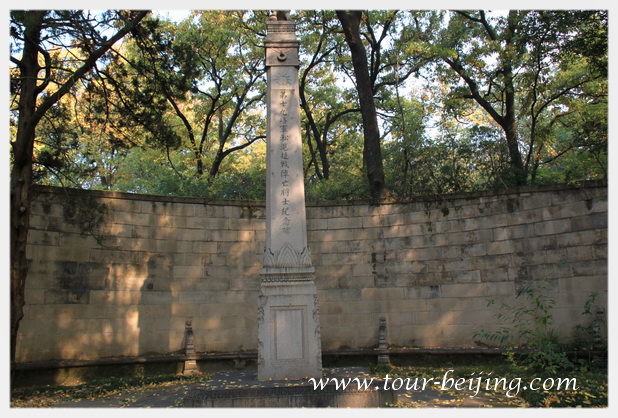
Linggu Pagoda was originally constructed in 1929 as a monument to the soldiers who died during the War of Northern Expedition (1926–1927).
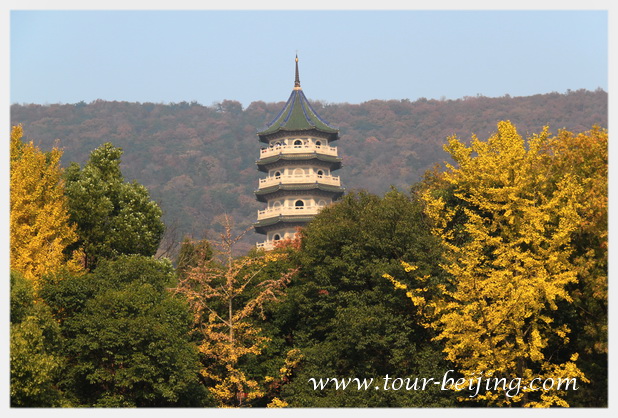
The 9 stories pagoda is 60.5 metres high, inscribed with the speeches made by Dr. Sun Yat-Sen and epigraphs of Chiang Kai-Shek.
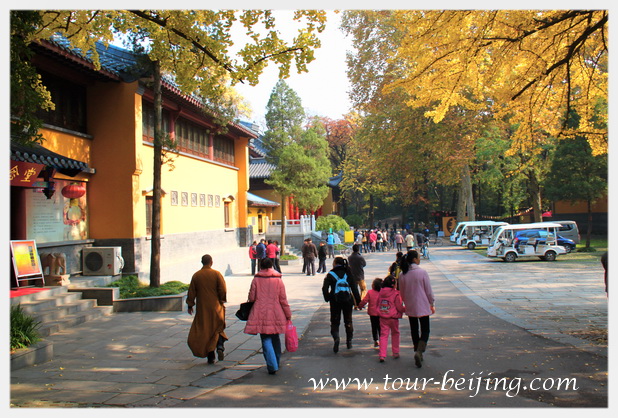
Tip: Hassle-free Jiangsu Guided Tours
If you don’t want to do a self-guided tour and prefer the hassle-free escorted tours, here are some options for organized tours to Jiangsu Province:
Nanjing Tour
Suzhou Tour
Jiangsu Tour
Further Readings
Top 10 Attractions in Nanjing
How to Visit Nanjing Massacre Memorial Hall
How to Visit Nanjing Confucius Temple-The Qinhuai River Scenic Area
How to Visit Zhonghua Gate Nanjing
How to Visit Nanjing Yangtze River Bridge
How to Visit Linggu Temple Scenic Area
Sun Yat-sen Mausoleum Music Stage
How to Visit Dr. Sun Yat-sen’s Mausoleum
How to Visit Ming Xiaoling Mausoleum
How to Visit Nanjing Presidential Palace
Nanjing South Railway Station
Nanjing Taxi: Nanjing Taxi Fares, Tips and Phones
Suzhou Railway Station
Suzhou Taxi: Suzhou Taxi Fares, Tips and Phones
Top 10 Attractions in Suzhou
Suzhou Railway Station
How to Visit Tongli Water Town
How to Visit Zhouzhuang Water Town
How to Visit Pingjiang Road in Suzhou
How to Visit The Garden of the Master of the Nets
How to visit Humble Administrator’s Garden
How to Visit Lion Grove Garden
How to Visit Canglang Pavilion
How to Visit Guanqian Street in Suzhou
4 Amazing Short Trip Ideas from Shanghai
Wuzhen Pictures – Wuzhen Photo Gallery
Zhouzhuang Pictures – Zhouzhuang Photo Gallery
Any questions, just drop a line.





